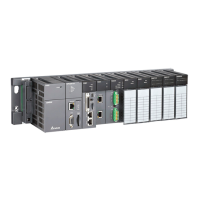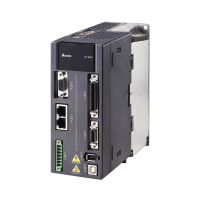AH500 Programming Manual
6-176
a) The PID algorithm includes the forward action and the reverse action. Whether the action
is the forward one or the reverse one depends on the setting of PID_DIR.
The PID algorithm is as follows.
( )
dt
tdE
KdttEKtEKMV
D
t
IP
)(
*)(
0
++=
∫
E(t)S represents the derivative value of E(t), and
represents the integral value of
.
Forward action
Reverse action
Control diagram: S represents the derivative action, and is defined as (Current
E(t)-previous E(t))/Sampling time. 1/S represents the integral action, and is defined as
(Previous integral value+Error value)×Sampling time. G(S) represents the plant.
G(s)
S
1/S
1/K
I
K
D
+
+
+
-
The instruction PID is inside the dotted line.
P
+
1/K
The symbols:
: Output value
: Error value
Forward action
Reverse action
: Proportional gain
: Process value
: Target value
: Derivative gain
: Integral gain
Suggestion:
1. Owing to the fact that the instruction PID can be used in a lot of controlled environments,
users have to choose the control function appropriately. For example, to prevent the
improper control from occurring, PID_MODE can not be used in the motor controlled
environment when it is set to 1.
2. When users tune the parameters K
P
, K
I
, and K
D
(PID_MODE is set to 0 or 2), they have to
tune the K
P
first (according to the experience), and then set set the K
I
and the K
D
to 0. When
users can handle the control, they can increase the K
I
and the K
D
, as illustrated in example
four below. When the K
P
is 100, it means that the proportional gain is 100%. That is, the error
value is increased by a factor of one. When the proportional gain is less than 100%, the error
value is decreased. When th proportional gain is larger than 100%, the error value is
increased.

